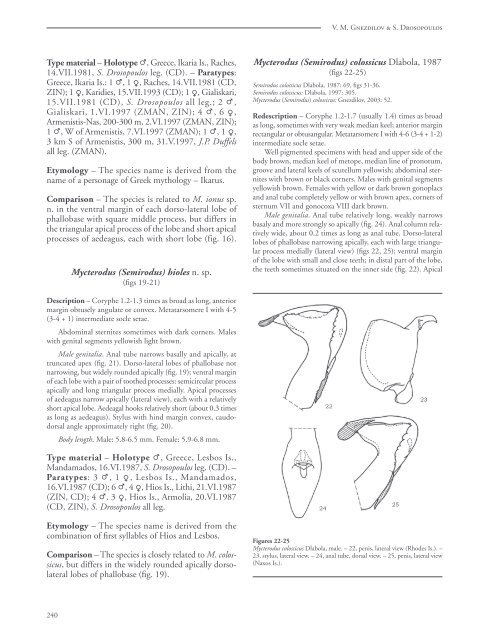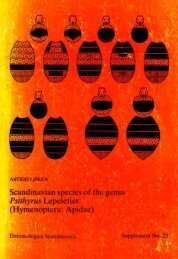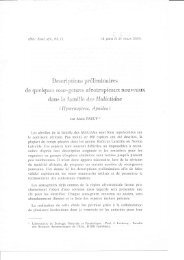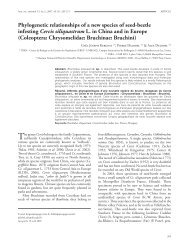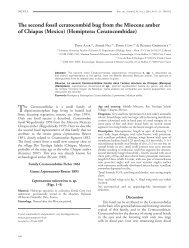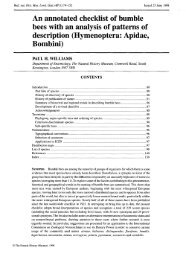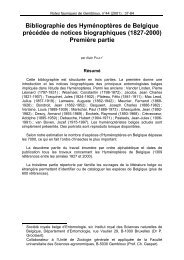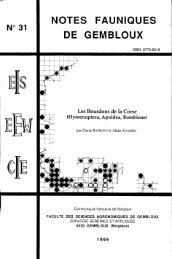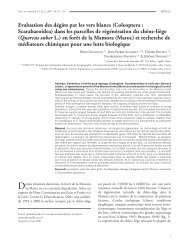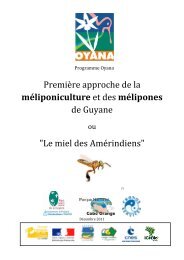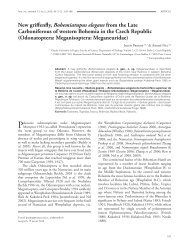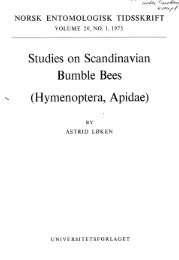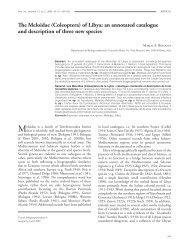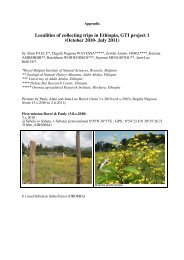Review of the subgenus Semirodus Dlabola of the genus Mycterodus
Review of the subgenus Semirodus Dlabola of the genus Mycterodus
Review of the subgenus Semirodus Dlabola of the genus Mycterodus
You also want an ePaper? Increase the reach of your titles
YUMPU automatically turns print PDFs into web optimized ePapers that Google loves.
V. M. Gnezdilov & S. Drosopoulos<br />
Type material – Holotype P, Greece, Ikaria Is., Raches,<br />
14.VII.1981, S. Drosopoulos leg. (CD). – Paratypes:<br />
Greece, Ikaria Is.: 1 P, 1 O, Raches, 14.VII.1981 (CD,<br />
ZIN); 1 O, Karidies, 15.VII.1993 (CD); 1 O, Gialiskari,<br />
15.VII.1981 (CD), S. Drosopoulos all leg.; 2 P,<br />
Gialiskari, 1.VI.1997 (ZMAN, ZIN); 4 P, 6 O,<br />
Armenistis-Nas, 200-300 m, 2.VI.1997 (ZMAN, ZIN);<br />
1 P, W <strong>of</strong> Armenistis, 7.VI.1997 (ZMAN); 1 P, 1 O,<br />
3 km S <strong>of</strong> Armenistis, 300 m, 31.V.1997, J.P. Duffels<br />
all leg. (ZMAN).<br />
Etymology – The species name is derived from <strong>the</strong><br />
name <strong>of</strong> a personage <strong>of</strong> Greek mythology – Ikarus.<br />
Comparison – The species is related to M. ionus sp.<br />
n. in <strong>the</strong> ventral margin <strong>of</strong> each dorso-lateral lobe <strong>of</strong><br />
phallobase with square middle process, but differs in<br />
<strong>the</strong> triangular apical process <strong>of</strong> <strong>the</strong> lobe and short apical<br />
processes <strong>of</strong> aedeagus, each with short lobe (fig. 16).<br />
<strong>Mycterodus</strong> (<strong>Semirodus</strong>) hioles n. sp.<br />
(figs 19-21)<br />
<strong>Mycterodus</strong> (<strong>Semirodus</strong>) colossicus <strong>Dlabola</strong>, 1987<br />
(figs 22-25)<br />
<strong>Semirodus</strong> colossicus <strong>Dlabola</strong>, 1987: 69, figs 31-36.<br />
<strong>Semirodus</strong> colossicus: <strong>Dlabola</strong>, 1997: 305.<br />
<strong>Mycterodus</strong> (<strong>Semirodus</strong>) colossicus: Gnezdilov, 2003: 52.<br />
Redescription – Coryphe 1.2-1.7 (usually 1.4) times as broad<br />
as long, sometimes with very weak median keel; anterior margin<br />
rectangular or obtusangular. Metatarsomere I with 4-6 (3-4 + 1-2)<br />
intermediate socle setae.<br />
Well pigmented specimens with head and upper side <strong>of</strong> <strong>the</strong><br />
body brown, median keel <strong>of</strong> metope, median line <strong>of</strong> pronotum,<br />
groove and lateral keels <strong>of</strong> scutellum yellowish; abdominal sternites<br />
with brown or black corners. Males with genital segments<br />
yellowish brown. Females with yellow or dark brown gonoplacs<br />
and anal tube completely yellow or with brown apex, corners <strong>of</strong><br />
sternum VII and gonocoxa VIII dark brown.<br />
Male genitalia. Anal tube relatively long, weakly narrows<br />
basaly and more strongly so apically (fig. 24). Anal column relatively<br />
wide, about 0.2 times as long as anal tube. Dorso-lateral<br />
lobes <strong>of</strong> phallobase narrowing apically, each with large triangular<br />
process medially (lateral view) (figs 22, 25); ventral margin<br />
<strong>of</strong> <strong>the</strong> lobe with small and close teeth; in distal part <strong>of</strong> <strong>the</strong> lobe,<br />
<strong>the</strong> teeth sometimes situated on <strong>the</strong> inner side (fig. 22). Apical<br />
Description – Coryphe 1.2-1.3 times as broad as long, anterior<br />
margin obtusely angulate or convex. Metatarsomere I with 4-5<br />
(3-4 + 1) intermediate socle setae.<br />
Abdominal sternites sometimes with dark corners. Males<br />
with genital segments yellowish light brown.<br />
Male genitalia. Anal tube narrows basally and apically, at<br />
truncated apex (fig. 21). Dorso-lateral lobes <strong>of</strong> phallobase not<br />
narrowing, but widely rounded apically (fig. 19); ventral margin<br />
<strong>of</strong> each lobe with a pair <strong>of</strong> too<strong>the</strong>d processes: semicircular process<br />
apically and long triangular process medially. Apical processes<br />
<strong>of</strong> aedeagus narrow apically (lateral view), each with a relatively<br />
short apical lobe. Aedeagal hooks relatively short (about 0.3 times<br />
as long as aedeagus). Stylus with hind margin convex, caudodorsal<br />
angle approximately right (fig. 20).<br />
Body length. Male: 5.8-6.5 mm. Female: 5.9-6.8 mm.<br />
Type material – Holotype P, Greece, Lesbos Is.,<br />
Mandamados, 16.VI.1987, S. Drosopoulos leg. (CD). –<br />
Paratypes: 3P, 1 O, Lesbos Is., Mandamados,<br />
16.VI.1987 (CD); 6 P, 4 O, Hios Is., Lithi, 21.VI.1987<br />
(ZIN, CD); 4 P, 3 O, Hios Is., Armolia, 20.VI.1987<br />
(CD, ZIN), S. Drosopoulos all leg.<br />
Etymology – The species name is derived from <strong>the</strong><br />
combination <strong>of</strong> first syllables <strong>of</strong> Hios and Lesbos.<br />
Comparison – The species is closely related to M. colossicus,<br />
but differs in <strong>the</strong> widely rounded apically dorsolateral<br />
lobes <strong>of</strong> phallobase (fig. 19).<br />
Figures 22-25<br />
<strong>Mycterodus</strong> colossicus <strong>Dlabola</strong>, male. – 22, penis, lateral view (Rhodes Is.). –<br />
23, stylus, lateral view. – 24, anal tube, dorsal view. – 25, penis, lateral view<br />
(Naxos Is.).<br />
240


